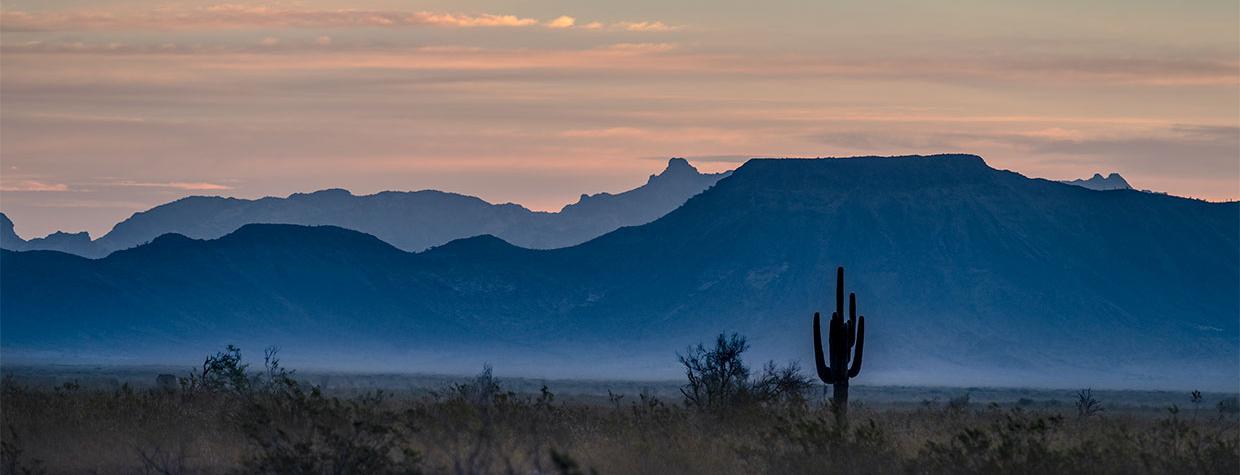It sounds like something out of the Wild West: a remote desert outpost, without electricity or running water, at the end of a rocky dirt road. The Hovatter family lived that reality — not in the 1800s, but for more than two decades in the mid-20th century. Today, road conditions make the site of the family’s homestead inaccessible to most passenger cars, but a 21.7-mile drive on the rest of Hovatter Road is rich in scenery, history and Sonoran Desert flora.
From Interstate 10 west of Phoenix, head south on Hovatter Road, which quickly becomes dirt and winds past a few communication towers. Early on, you’ll see plenty of ocotillos and saguaro cactuses, and you might notice that some of the latter are paired with dead, leafless trees. These “nurse trees” shelter young saguaros from animals and the elements, allowing the cactuses to reach maturity. The trees’ reward: being deprived of water by the cactuses they helped nurture. It’s a tough break, but that’s nature for you.
Past the towers, the road turns to the southwest, and you’ll see Coyote Peak, an isolated butte that reaches an elevation of 2,100 feet, straight ahead. It grows larger in the windshield as you cross a broad, sandy wash, and by 10 miles into the drive, you’ll have a better idea of how imposing it is. Hovatter Road then merges with Vicksburg Road and continues south.
Next, on the right, you’ll see a historical marker. This is the site of Bob Crowder Memorial Dam, a small earthen dam built in the 1960s and named in honor of an early Arizona cattleman and his “fortitude and ambition to develop water in these vast desert areas.” From here, you also can see a smaller, steep-walled butte that previously was obscured by Coyote Peak.
The road next turns to the southeast and begins its climb into the Little Horn Mountains, a range popular among rock climbers and all-terrain-vehicle riders. Here, you’ll find more greenery than earlier in the drive, with saguaros, ocotillos and mesquite trees forming a picturesque portrait of the Sonoran Desert. At Mile 14.5, thousands of teddy bear chollas join the party, blanketing the hills on both sides of the road.
By Mile 19, you’ll be surrounded by the Little Horns’ jagged buttes, along with tall saguaros and mesquites. Here, the road crosses from La Paz County to Yuma County and becomes slightly rougher for its final stretch. Past slopes covered with black boulders, you’ll traverse a vast field of ocotillos and chollas before reaching the turnoff for the Fancher Mine, an ongoing gold and silver operation, at Mile 21.7.
For most travelers, this is your turnaround point. But those with all-terrain tires (or, better yet, an ATV) can continue straight ahead for 6 miles, across washes and over rocky slopes, to the site of the Hovatter homestead, where two graves and a driveway lined with transplanted saguaros are among the only remnants of the family’s outpost. The Hovatters — parents Ray and Barbara, plus their three daughters — lived here from 1951 to the mid-1970s. One of the children was fatally injured in a propane tank explosion in 1968, and she and her father, who died in 1974, are buried at the homestead site, which today is just inside the eastern boundary of Kofa National Wildlife Refuge.
Tour Guide
Note: Mileages are approximate.
Length: 21.7 miles one way (from Interstate 10)
Directions: From Phoenix, go west on Interstate 10 for 88 miles to Hovatter Road (Exit 53). Turn left (south) onto Hovatter Road and continue 0.6 miles to a “T” intersection. Turn left to stay on Hovatter Road and continue 21.1 miles to the Fancher Mine turnoff.
Vehicle requirements: A high-clearance vehicle, such as an SUV or truck, is required, but four-wheel-drive is not necessary in good weather. Continuing past the turnaround point to the Hovatter homestead site requires four-wheel-drive and all-terrain tires. The route crosses several washes, so do not attempt the drive after recent rain or if rain is in the forecast.
Warning: Back-road travel can be hazardous, so be aware of weather and road conditions. Carry plenty of water. Don’t travel alone, and let someone know where you are going and when you plan to return.
Information: Kofa National Wildlife Refuge, 928-783-7861 or fws.gov/refuge/kofa

